Increased Oral Bioavailability of Resveratrol by Its Encapsulation in Casein Nanoparticles
Abstract
1. Introduction
2. Results
2.1. Characterization of Nanoparticles
2.2. In Vitro Release Studies
2.3. In Vivo Biodistribution Study of Casein Nanoparticles
2.4. Pharmacokinetic Studies in Wistar Rats
2.5. In Vitro-In Vivo Correlations
3. Discussion
4. Materials and Methods
4.1. Reagents
4.2. Preparation of Resveratrol-Loaded Nanoparticles
4.3. Preparation of Resveratrol Conventional Formulations
4.4. Characterization of Resveratrol-Loaded Nanoparticles
4.4.1. Physicochemical Characterization
4.4.2. Resveratrol Analysis
4.5. In Vitro Release Studies
4.6. Labelling of Casein Nanoparticles
4.6.1. Radiolabeling of Casein Nanoparticles (NP-NOTA-Ga)
4.6.2. Fluorescently Labelling of Casein Nanoparticles (LR-NP)
4.7. In Vivo Biodistribution Studies
4.8. In Vivo Pharmacokinetic Studies in Wistar Rats
4.8.1. Determination of Resveratrol and Rsv-3-O-d-Glucuronide Plasma Concentration by HPLC
4.8.2. Pharmacokinetic Data Analysis
4.9. In Vitro-In Vivo Correlations (IVIVC)
4.10. Statistical Analysis
5. Conclusions
Author Contributions
Funding
Disclosures Section
Conflicts of Interest
Abbreviations
| AUC | Area under the curve |
| Cl | Clearance |
| Cmax | peak plasma concentration |
| DAPI | 4′,6-diamidino-2-phenylindole |
| E.E. | encapsulation efficiency |
| Fr | relative oral bioavailability |
| FRA | fraction of resveratrol absorbed |
| FRD | fraction of resveratrol released |
| IVIVC | In vitro-in vivo correlations |
| LR-NP | Lumogen red-loaded casein nanoparticles |
| MRT | mean residence time |
| NP-C | empty casein nanoparticles |
| NP-NOTA-Ga | casein nanoparticles radiolabeled with Gallium-67 |
| PCS | photon correlation spectroscopy |
| PDI | polydispersity index |
| PEG | polyethylene glycol 400 |
| Rsv | resveratrol |
| Rsv-IV | resveratrol solution intravenously administered |
| Rsv-NP-C | resveratrol-loaded casein nanoparticles |
| Rsv-Sol | solution of resveratrol in a mixture of PEG 400 and water |
| Rsv-Susp | aqueous suspension of resveratrol |
| SGF | simulated gastric fluid |
| SIF | simulated intestinal fluid |
| t1/2 | half-life of the terminal phase |
| Tmax | time to reach plasma concentration |
References
- Guerrero, R.F.; García-Parrilla, M.C.; Puertas, B.; Cantos-Villar, E. Wine, resveratrol and health: A review. Nat. Prod. Commun. 2009, 4, 635–658. [Google Scholar] [PubMed]
- Baur, J.A.; Sinclair, D.A. Therapeutic potential of resveratrol: The in vivo evidence. Nat. Rev. Drug Discov. 2006, 5, 493–506. [Google Scholar] [CrossRef] [PubMed]
- Pangeni, R.; Sahni, J.K.; Ali, J.; Sharma, S.; Baboota, S. Resveratrol: Review on therapeutic potential and recent advances in drug delivery. Expert Opin. Drug Deliv. 2014, 11, 1285–1298. [Google Scholar] [CrossRef] [PubMed]
- Renaud, S.; de Lorgeril, M. Wine, alcohol, platelets, and the French paradox for coronary heart disease. Lancet 1992, 339, 1523–1526. [Google Scholar] [CrossRef]
- Valentovic, M.A. Evaluation of resveratrol in cancer patients and experimental models. Adv. Cancer Res. 2018, 137, 171–188. [Google Scholar] [CrossRef] [PubMed]
- Davidov-Pardo, G.; McClements, D.J. Nutraceutical delivery systems: Resveratrol encapsulation in grape seed oil nanoemulsions formed by spontaneous emulsification. Food Chem. 2015, 167, 205–212. [Google Scholar] [CrossRef] [PubMed]
- Vasanthi, H.R.; ShriShriMal, N.; Das, D.K. Phytochemicals from plants to combat cardiovascular disease. Curr. Med. Chem. 2012, 19, 2242–2251. [Google Scholar] [CrossRef] [PubMed]
- Yang, Y.M.; Chen, J.Z.; Wang, X.X.; Wang, S.J.; Hu, H.; Wang, H.Q. Resveratrol attenuates thromboxane A2 receptor agonist-induced platelet activation by reducing phospholipase C activity. Eur. J. Pharmacol. 2008, 583, 148–155. [Google Scholar] [CrossRef] [PubMed]
- Orallo, F.; Alvarez, E.; Camiña, M.; Leiro, J.M.; Gómez, E.; Fernández, P. The possible implication of trans-resveratrol in the cardioprotective effects of long-term moderate wine consumption. Mol. Pharmacol. 2002, 61, 294–302. [Google Scholar] [CrossRef] [PubMed]
- Athar, M.; Back, J.H.; Tang, X.; Kim, K.H.; Kopelovich, L.; Bickers, D.R.; Kim, A.L. Resveratrol: A review of preclinical studies for human cancer prevention. Toxicol. Appl. Pharmacol. 2007, 224, 274–283. [Google Scholar] [CrossRef] [PubMed]
- Kang, O.-H.; Jang, H.J.; Chae, H.S.; Oh, Y.C.; Choi, J.G.; Lee, Y.S.; Kim, J.H.; Kim, Y.C.; Sohn, D.H.; Park, H.; et al. Anti-inflammatory mechanisms of resveratrol in activated HMC-1 cells: Pivotal roles of NF-kappaB and MAPK. Pharmacol. Res. 2009, 59, 330–337. [Google Scholar] [CrossRef] [PubMed]
- Slater, S.J.; Seiz, J.L.; Cook, A.C.; Stagliano, B.A.; Buzas, C.J. Inhibition of protein kinase C by resveratrol. Biochim. Biophys. Acta 2003, 1637, 59–69. [Google Scholar] [CrossRef]
- Kamaleddin, M.A. The paradoxical pro- and antiangiogenic actions of resveratrol: Therapeutic applications in cancer and diabetes. Ann. N. Y. Acad. Sci. 2016, 1386, 3–15. [Google Scholar] [CrossRef] [PubMed]
- Amri, A.; Chaumeil, J.C.; Sfar, S.; Charrueau, C. Administration of resveratrol: What formulation solutions to bioavailability limitations? J. Control Release 2012, 158, 182–193. [Google Scholar] [CrossRef] [PubMed]
- Camont, L.; Cottart, C.H.; Rhayem, Y.; Nivet-Antoine, V.; Djelidi, R.; Collin, F.; Beaudeux, J.L.; Bonnefont-Rousselot, D. Simple spectrophotometric assessment of the trans-/cis-resveratrol ratio in aqueous solutions. Anal. Chim. Acta 2009, 634, 121–128. [Google Scholar] [CrossRef] [PubMed]
- Rius, C.; Abu-Taha, M.; Hermenegildo, C.; Piqueras, L.; Cerda-Nicolas, J.M.; Issekutz, A.C.; Estañ, L.; Cortijo, J.; Morcillo, E.J.; Orallo, F.; et al. Trans- but not cis-resveratrol impairs angiotensin-II-mediated vascular inflammation through inhibition of NF-κB activation and peroxisome proliferator-activated receptor-gamma upregulation. J. Immunol. 2010, 185, 3718–3727. [Google Scholar] [CrossRef] [PubMed]
- Planas, J.M.; Alfaras, I.; Colom, H.; Juan, M.E. The bioavailability and distribution of trans-resveratrol are constrained by ABC transporters. Arch. Biochem. Biophys. 2012, 527, 67–73. [Google Scholar] [CrossRef] [PubMed]
- Radko, Y.; Christensen, K.B.; Christensen, L.P. Semi-preparative isolation of dihydroresveratrol-3-O-β-d-glucuronide and four resveratrol conjugates from human urine after oral intake of a resveratrol-containing dietary supplement. J. Chromatogr. B Anal. Technol. Biomed. Life Sci. 2013, 930, 54–61. [Google Scholar] [CrossRef] [PubMed]
- Ruotolo, R.; Calani, L.; Fietta, E.; Brighenti, F.; Crozier, A.; Meda, C.; Maggi, A.; Ottonello, S.; Del Rio, D. Anti-estrogenic activity of a human resveratrol metabolite. Nutr. Metab. Cardiovasc. Dis. 2013, 23, 1086–1092. [Google Scholar] [CrossRef] [PubMed]
- Penalva, R.; Esparza, I.; Agüeros, M.; Gonzalez-Navarro, C.J.; Gonzalez-Ferrero, C.; Irache, J.M. Casein nanoparticles as carriers for the oral delivery of folic acid. Food Hydrocolloids 2015, 44, 399–406. [Google Scholar] [CrossRef]
- Acharya, D.P.; Sanguansri, L.; Augustin, M.A. Binding of resveratrol with sodium caseinate in aqueous solutions. Food Chem. 2013, 141, 1050–1054. [Google Scholar] [CrossRef] [PubMed]
- Bourassa, P.; Bariyanga, J.; Tajmir-Riahi, H.A. Binding sites of resveratrol, genistein, and curcumin with milk α- and β-caseins. J. Phys. Chem. B 2013, 117, 1287–1295. [Google Scholar] [CrossRef] [PubMed]
- Liang, L.; Tajmir-Riahi, H.A.; Subirade, M. Interaction of beta-lactoglobulin with resveratrol and its biological implications. Biomacromolecules 2008, 9, 50–56. [Google Scholar] [CrossRef] [PubMed]
- Zhang, J.; Mi, Q.; Shen, M. Resveratrol binding to collagen and its biological implication. Food Chem. 2012, 131, 879–884. [Google Scholar] [CrossRef]
- Bernstein, L.R. Mechanisms of therapeutic activity for gallium. Pharmacol. Rev. 1998, 50, 665–682. [Google Scholar] [PubMed]
- Jose, S.; Anju, S.S.; Cinu, T.A.; Aleykutty, N.A.; Thomas, S.; Souto, E.B. In vivo pharmacokinetics and biodistribution of resveratrol-loaded solid lipid nanoparticles for brain delivery. Int. J. Pharm. 2014, 474, 6–13. [Google Scholar] [CrossRef] [PubMed]
- Cho, A.R.; Chun, Y.G.; Kim, B.K.; Park, D.J. Preparation of chitosan-TPP microspheres as resveratrol carriers. J. Food Sci. 2014, 79, E568–E576. [Google Scholar] [CrossRef] [PubMed]
- Neves, A.R.; Lúcio, M.; Martins, S.; Lima, J.L.C.; Reis, S. Novel resveratrol nanodelivery systems based on lipid nanoparticles to enhance its oral bioavailability. Int. J. Nanomed. 2013, 8, 177–187. [Google Scholar] [CrossRef]
- Pando, D.; Gutiérrez, G.; Coca, J.; Pazos, C. Preparation and characterization of niosomes containing resveratrol. J. Food Eng. 2013, 117, 227–234. [Google Scholar] [CrossRef]
- Bajpai, S.K. Casein cross-linked polyacrylamide hydrogels: Study of swelling and drug release behaviour. Iran. Pol. J. 1999, 8, 231–240. [Google Scholar]
- Heelan, B.A.; Corrigan, O.I. In vitro analysis of the release of incorporated agents from sodium caseinate microspheres. J. Microencaps. 1997, 14, 63–78. [Google Scholar] [CrossRef]
- Colom, H.; Alfaras, I.; Maijó, M.; Juan, M.E.; Planas, J.M. Population pharmacokinetic modeling of trans-resveratrol and its glucuronide and sulfate conjugates after oral and intravenous administration in rats. Pharm. Res. 2011, 28, 1606–1621. [Google Scholar] [CrossRef] [PubMed]
- Cottart, C.H.; Nivet-Antoine, V.; Laguillier-Morizot, C.; Beaudeux, J.L. Resveratrol bioavailability and toxicity in humans. Mol. Nutr. Food Res. 2010, 54, 7–16. [Google Scholar] [CrossRef] [PubMed]
- Walle, T. Bioavailability of resveratrol. Ann. N. Y. Acad. Sci. 2011, 1215, 9–15. [Google Scholar] [CrossRef] [PubMed]
- Maier-Salamon, A.; Hagenauer, B.; Reznicek, G.; Szekeres, T.; Thalhammer, T.; Jäger, W. Metabolism and disposition of resveratrol in the isolated perfused rat liver: Role of Mrp2 in the biliary excretion of glucuronides. J. Pharm. Sci. 2008, 97, 1615–1628. [Google Scholar] [CrossRef] [PubMed]
- Singh, G.; Pai, R.S. Trans-resveratrol self-nano-emulsifying drug delivery system (SNEDDS) with enhanced bioavailability potential: Optimization, pharmacokinetics and in situ single pass intestinal perfusion (SPIP) studies. Drug Deliv. 2015, 22, 522–530. [Google Scholar] [CrossRef] [PubMed]
- Pandita, D.; Kumar, S.; Poonia, N.; Lather, V. Solid lipid nanoparticles enhance oral bioavailability of resveratrol, a natural polyphenol. Food Res. Int. 2014, 62, 1165–1174. [Google Scholar] [CrossRef]
- Ramalingam, P.; Ko, Y.T. Improved oral delivery of resveratrol from N-trimethyl chitosan-g-palmitic acid surface-modified solid lipid nanoparticles. Colloids Surf. B Biointerfaces 2016, 139, 52–61. [Google Scholar] [CrossRef] [PubMed]
- Elzoghby, A.O.; El-Fotoh, W.S.A.; Elgindy, N.A. Casein-based formulations as promising controlled release drug delivery systems. J. Control Release 2011, 153, 206–216. [Google Scholar] [CrossRef] [PubMed]
- Kuhnle, G.; Spencer, J.P.; Chowrimootoo, G.; Schroeter, H.; Debnam, E.S.; Srai, S.K.; Rice-Evans, C.; Hahn, U. Resveratrol is absorbed in the small intestine as resveratrol glucuronide. Biochem. Biophys. Res. Commun. 2000, 272, 212–217. [Google Scholar] [CrossRef] [PubMed]
- Maier-Salamon, A.; Hagenauer, B.; Wirth, M.; Gabor, F.; Szekeres, T.; Jäger, W. Increased transport of resveratrol across monolayers of the human intestinal Caco-2 cells is mediated by inhibition and saturation of metabolites. Pharm. Res. 2006, 23, 2107–2115. [Google Scholar] [CrossRef] [PubMed]
- Rotches-Ribalta, M.; Andres-Lacueva, C.; Estruch, R.; Escribano, E.; Urpi-Sarda, M. Pharmacokinetics of resveratrol metabolic profile in healthy humans after moderate consumption of red wine and grape extract tablets. Pharmacol. Res. 2012, 66, 375–382. [Google Scholar] [CrossRef] [PubMed]
- Trevaskis, N.L.; Kaminskas, L.M.; Porter, C.J. From sewer to saviour—Targeting the lymphatic system to promote drug exposure and activity. Nat. Rev. Drug Dis. 2015, 14, 781–803. [Google Scholar] [CrossRef] [PubMed]
- Penalva, R.; Esparza, I.; Larraneta, E.; González-Navarro, C.J.; Gamazo, C.; Irache, J.M. Zein based-nanoparticles improve the oral bioavailability of resveratrol and its anti-inflammatory effects in a mouse model of endotoxic shock. J. Agric. Food Chem. 2015, 63, 5603–5611. [Google Scholar] [CrossRef] [PubMed]
- Ritger, P.L.; Peppas, N.A. A simple equation for description of solute release I. Fickian and non-fickian release from non-swellable devices in the form of slabs, spheres, cylinders or discs. J. Control. Release 1987, 5, 23–36. [Google Scholar] [CrossRef]
- Costa, P.; Sousa Lobo, J.M. Modeling and comparison of dissolution profiles. Eur. J. Pharm. Sci. 2001, 13, 123–133. [Google Scholar] [CrossRef]
- Morfin, J.F.; Tóth, É. Kinetics of Ga(NOTA) formation from weak Ga-citrate complexes. Inorg. Chem. 2011, 50, 10371–10378. [Google Scholar] [CrossRef] [PubMed]
- Boocock, D.J.; Patel, K.R.; Faust, G.E.; Normolle, D.P.; Marczylo, T.H.; Crowell, J.A.; Brenner, D.E.; Booth, T.D.; Gescher, A.; Steward, W.P. Quantitation of trans-resveratrol and detection of its metabolites in human plasma and urine by high performance liquid chromatography. J. Chromatogr. B Anal. Technol. Biomed. Life Sci. 2007, 848, 182–187. [Google Scholar] [CrossRef] [PubMed]
- Sakore, S.; Chakraborty, B. In Vitro—In Vivo Correlation (IVIVC): A strategic tool in drug development. J. Bioequiv. Availab. 2011, S3. [Google Scholar] [CrossRef]
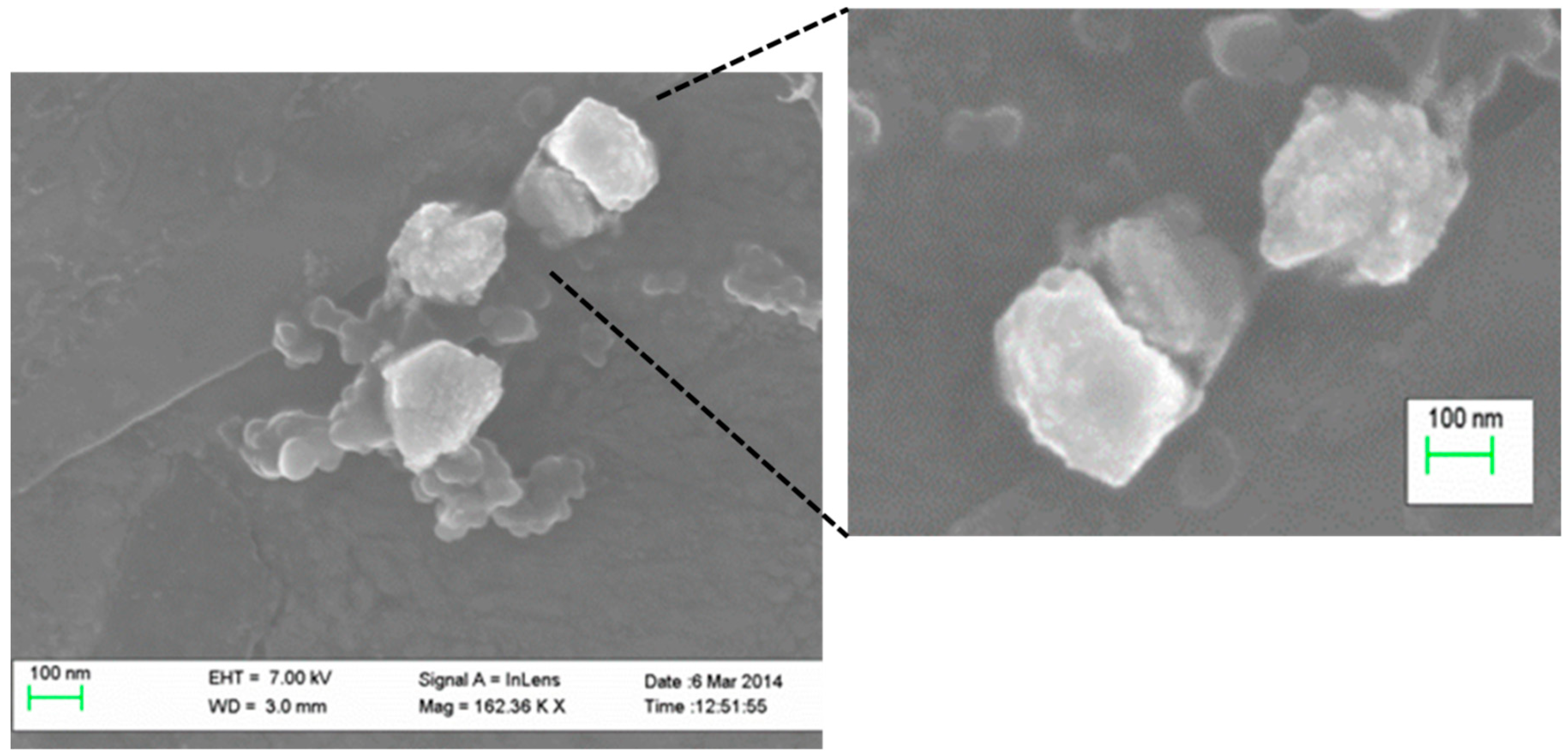
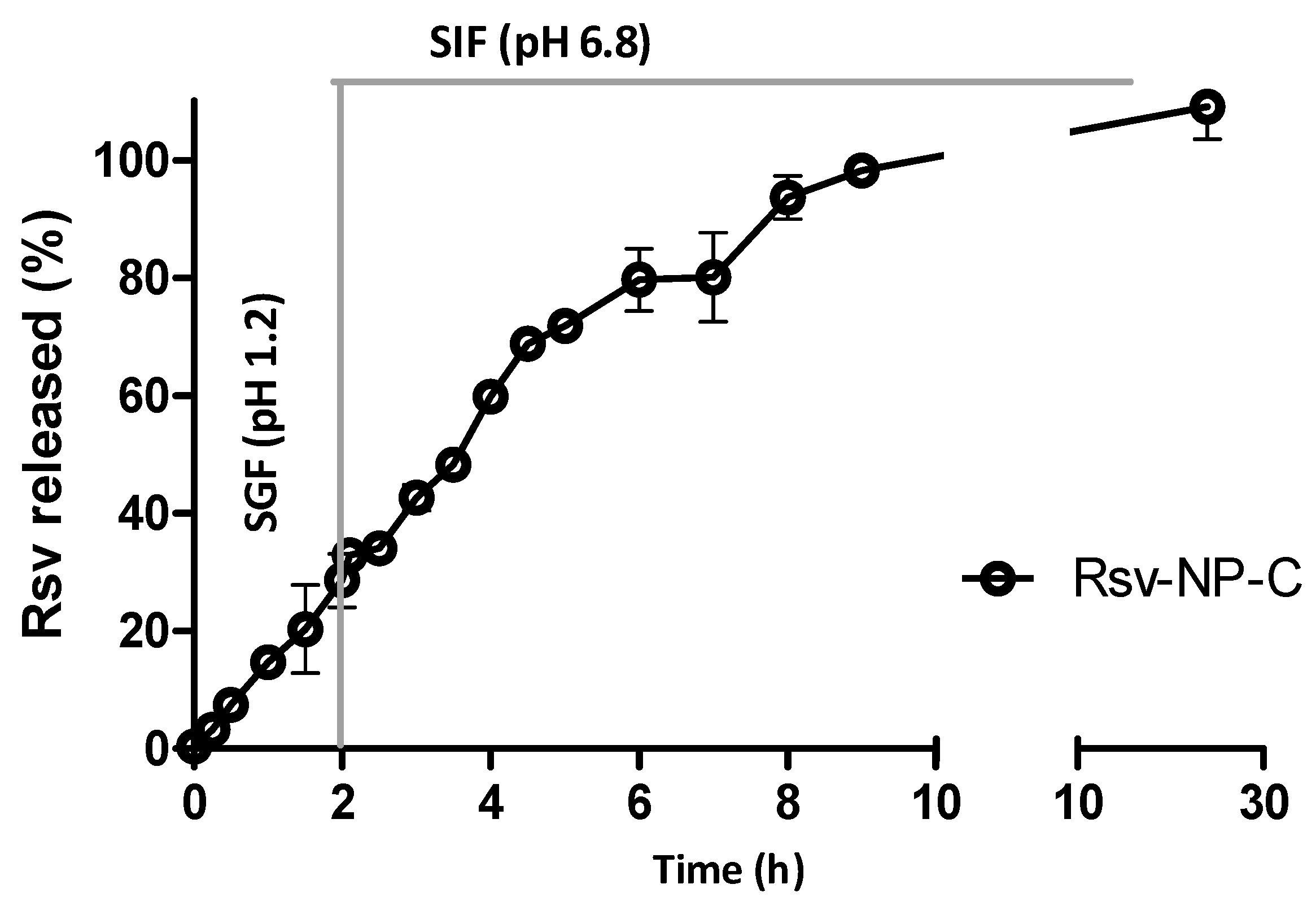
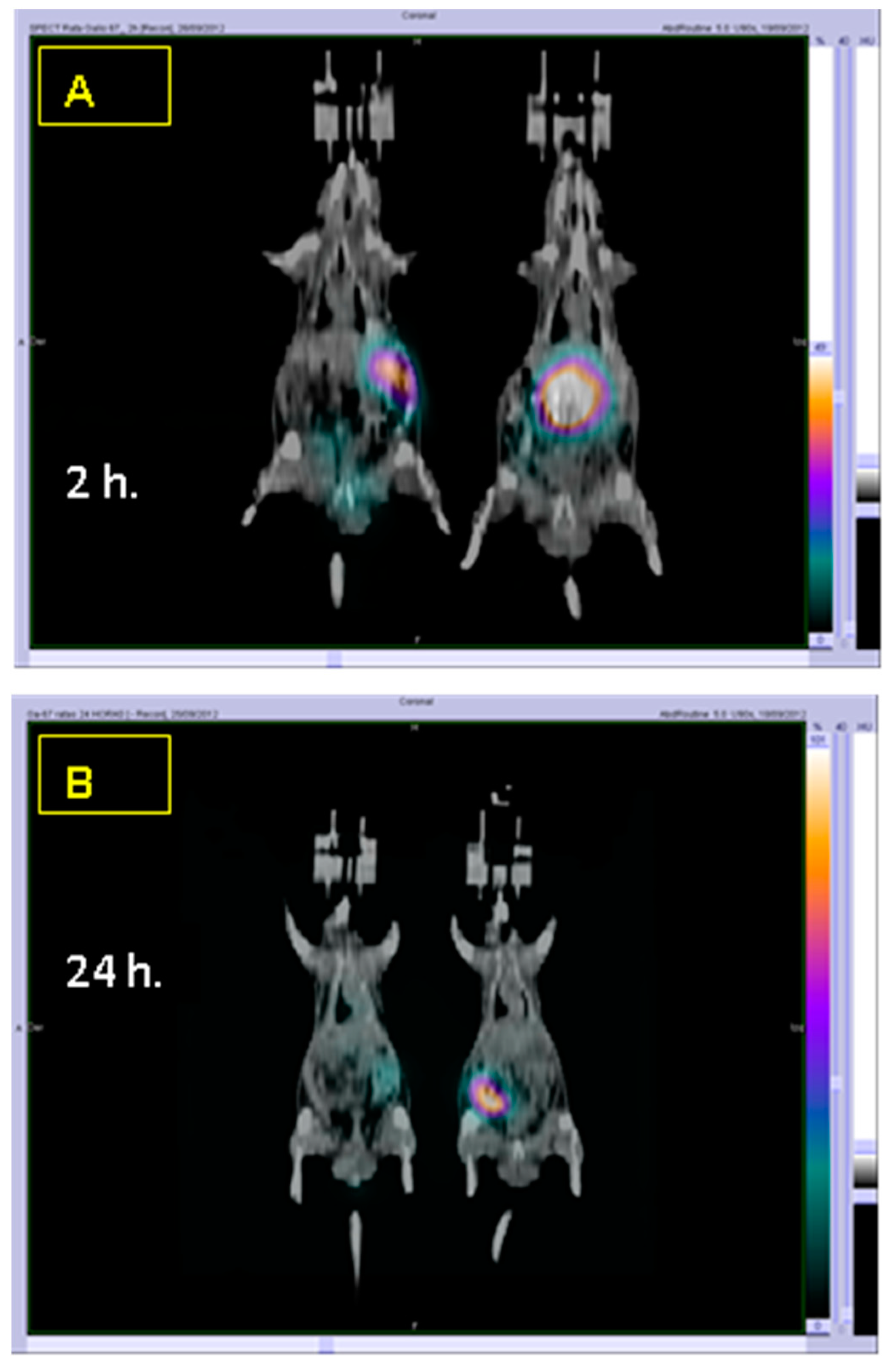

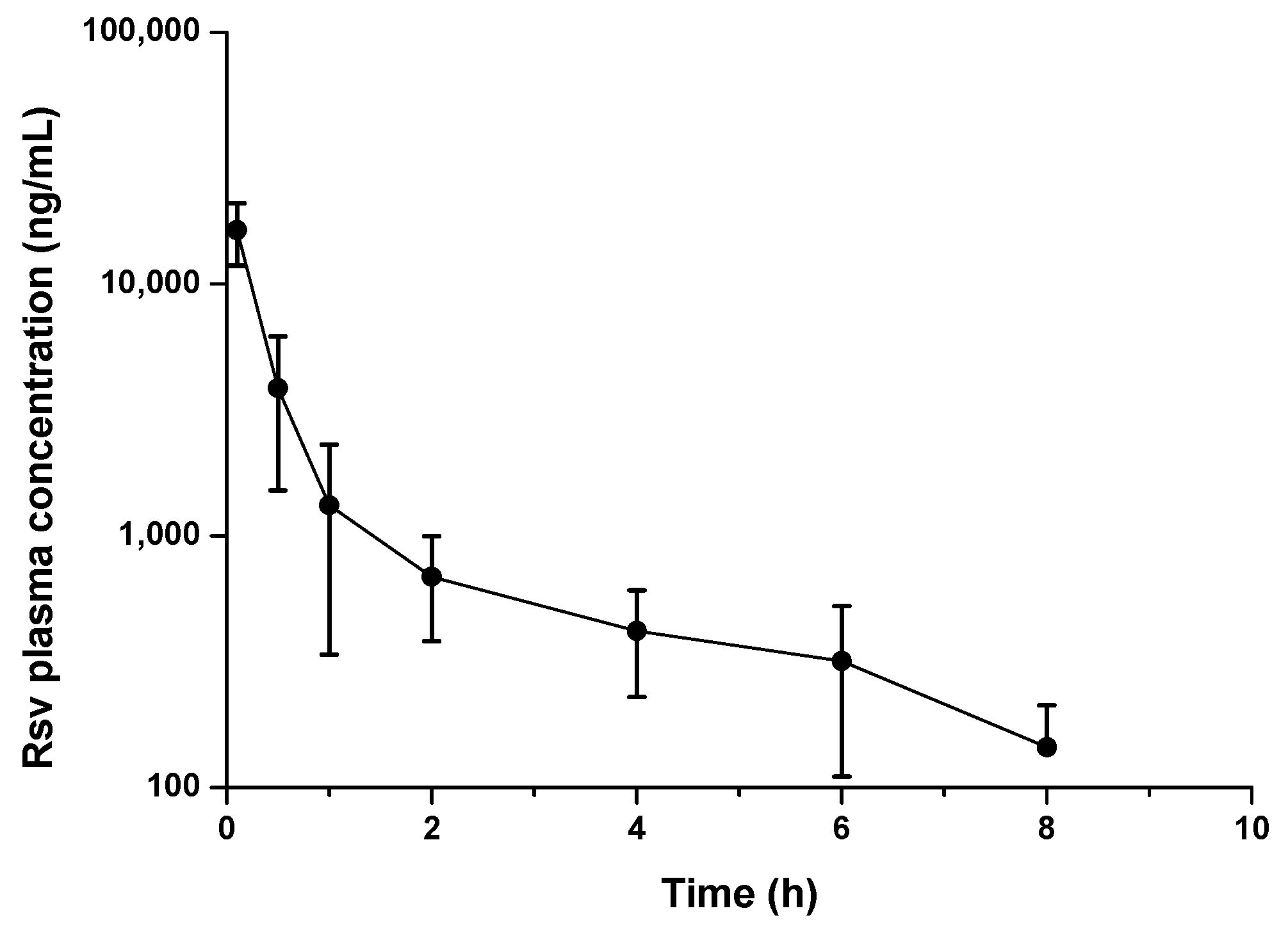
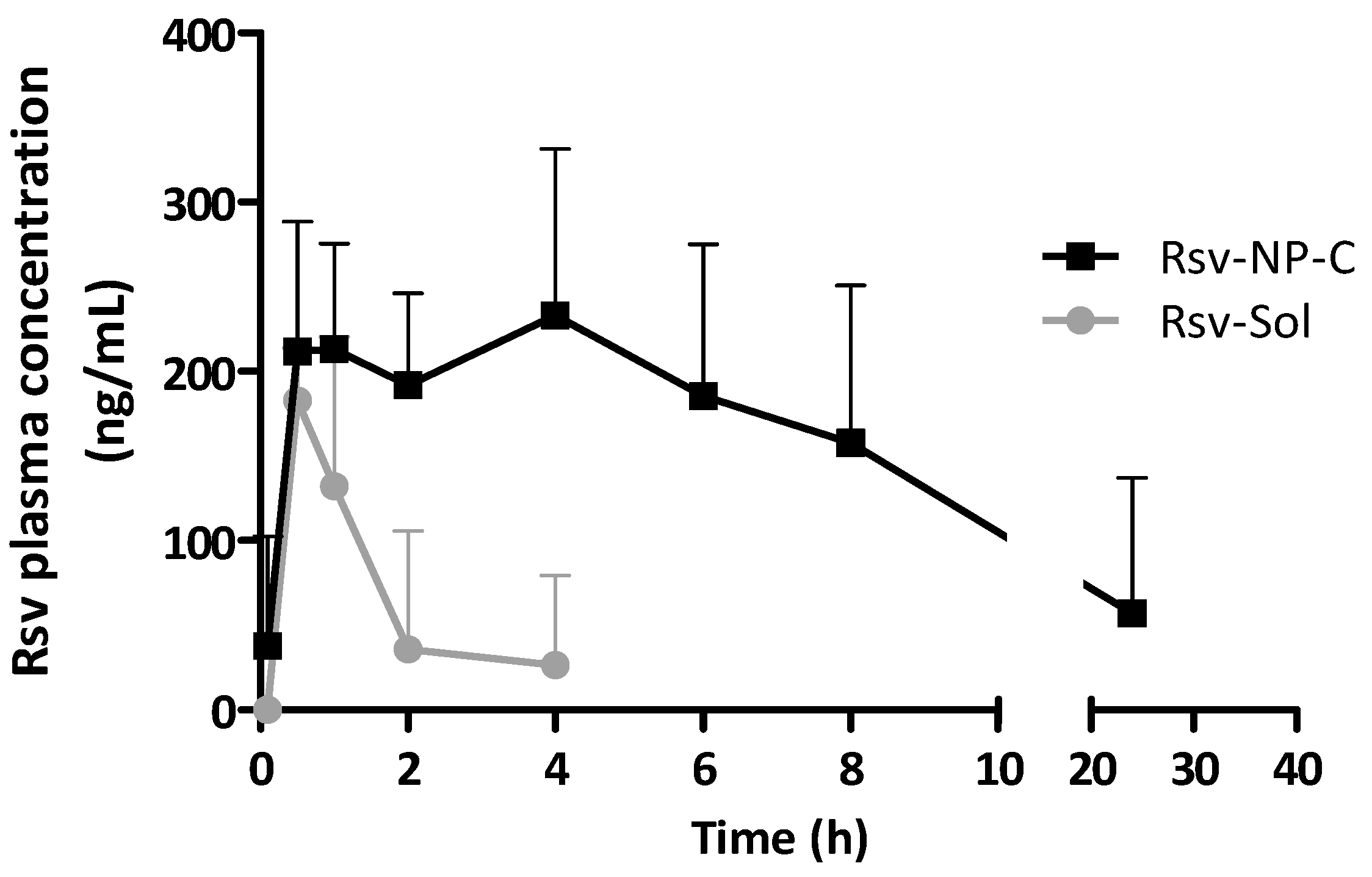
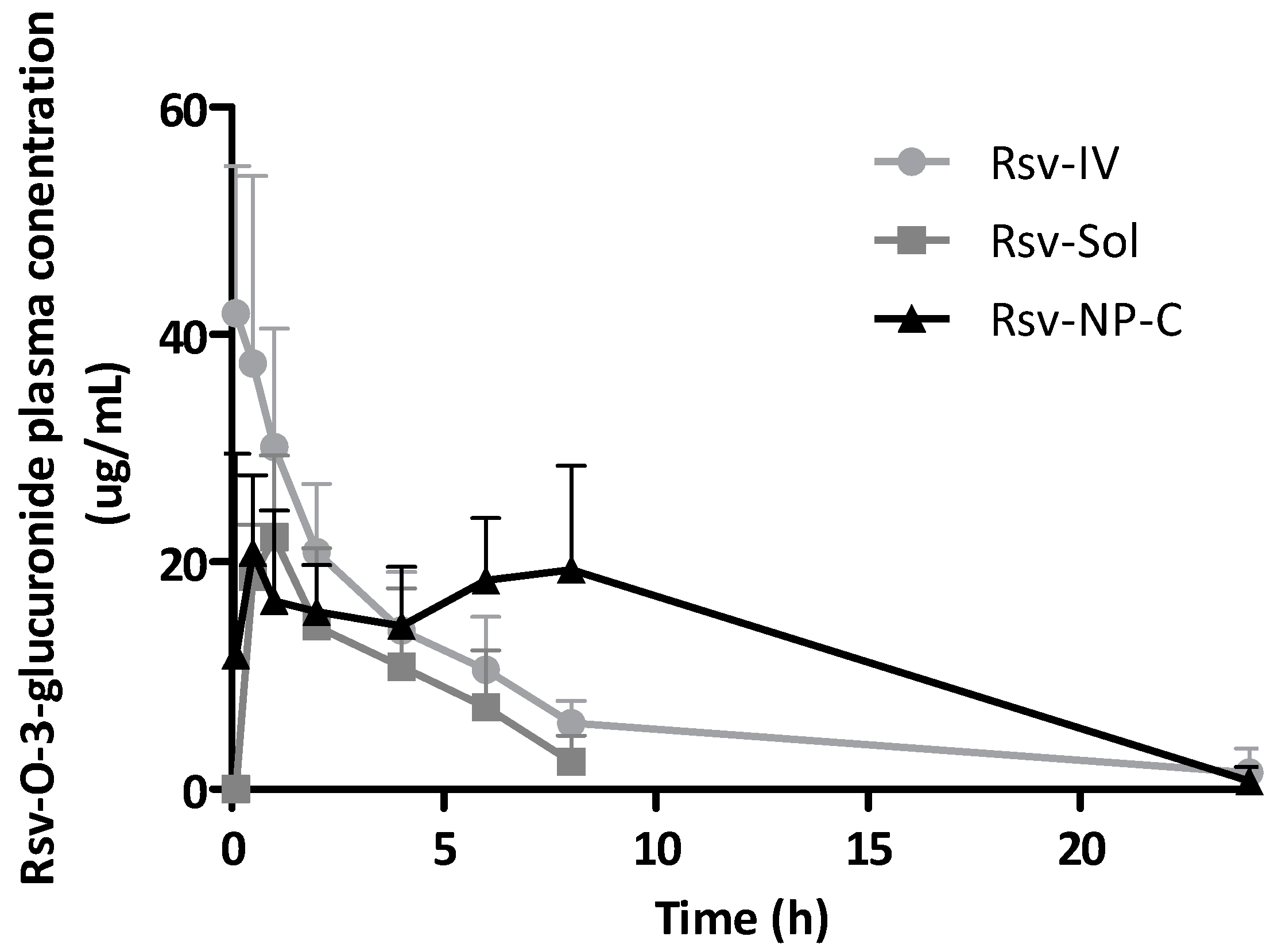
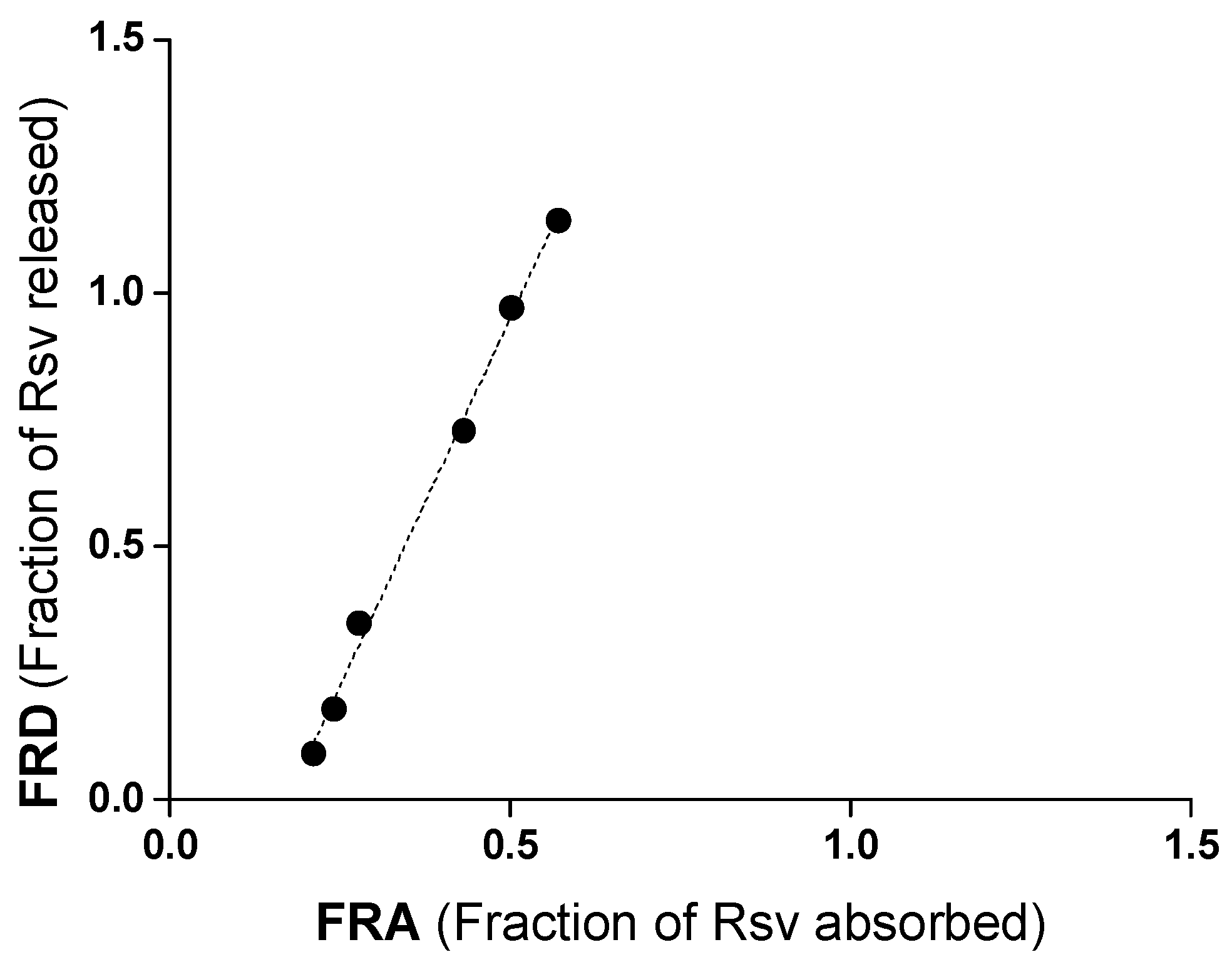
| Formulation | Size (nm) | PDI (nm) | Zeta Potential (mV) | Rsv Loading (µg/mg) | E.E. (%) |
|---|---|---|---|---|---|
| NP-C | 138 ± 6 | 0.19 ± 0.02 | −12 ± 1 | ||
| Rsv-NP-C | 210 ± 3 | 0.20 ± 0.02 | −19 ± 1 | 31 ± 1 | 68 ± 3 |
| Formulation | Route | Cmax (µg/mL) | Tmax (h) | AUC (µg h/mL) | t1/2 (h) | Cl (mL/h) | Vd (mL) | MRT (h) | Fr (%) |
|---|---|---|---|---|---|---|---|---|---|
| Rsv-IV | iv | 15.2 ± 5.18 | 0.1 ± 0.0 | 10.4 ± 3.80 | 2.0 ± 0.5 | 199.4 ± 89.81 | 569.2 ± 221.4 | 2.4 ± 1.0 | 100 |
| Rsv-Sol | po | 0.20 ± 0.02 ** | 0.6 ± 0.2 | 0.28 ± 0.13 | 0.3 ± 0.2 ** | 386.7 ± 224.9 | 112.3 ±103.6 ** | 1.3 ± 0.8 * | 2.6 |
| Rsv-Susp | po | - | - | - | - | - | - | - | - |
| Rsv-NP-C | po | 0.29 ± 0.07 **† | 1.8 ± 1.3 | 2.76 ± 1.64 **†† | 2.7 ± 0.7 †† | 161.8 ± 69.86 | 661.7 ± 242.9 †† | 8.2 ± 3.7 **†† | 26.5 |
© 2018 by the authors. Licensee MDPI, Basel, Switzerland. This article is an open access article distributed under the terms and conditions of the Creative Commons Attribution (CC BY) license (http://creativecommons.org/licenses/by/4.0/).
Share and Cite
Peñalva, R.; Morales, J.; González-Navarro, C.J.; Larrañeta, E.; Quincoces, G.; Peñuelas, I.; Irache, J.M. Increased Oral Bioavailability of Resveratrol by Its Encapsulation in Casein Nanoparticles. Int. J. Mol. Sci. 2018, 19, 2816. https://doi.org/10.3390/ijms19092816
Peñalva R, Morales J, González-Navarro CJ, Larrañeta E, Quincoces G, Peñuelas I, Irache JM. Increased Oral Bioavailability of Resveratrol by Its Encapsulation in Casein Nanoparticles. International Journal of Molecular Sciences. 2018; 19(9):2816. https://doi.org/10.3390/ijms19092816
Chicago/Turabian StylePeñalva, Rebeca, Jorge Morales, Carlos J. González-Navarro, Eneko Larrañeta, Gemma Quincoces, Ivan Peñuelas, and Juan M. Irache. 2018. "Increased Oral Bioavailability of Resveratrol by Its Encapsulation in Casein Nanoparticles" International Journal of Molecular Sciences 19, no. 9: 2816. https://doi.org/10.3390/ijms19092816
APA StylePeñalva, R., Morales, J., González-Navarro, C. J., Larrañeta, E., Quincoces, G., Peñuelas, I., & Irache, J. M. (2018). Increased Oral Bioavailability of Resveratrol by Its Encapsulation in Casein Nanoparticles. International Journal of Molecular Sciences, 19(9), 2816. https://doi.org/10.3390/ijms19092816







